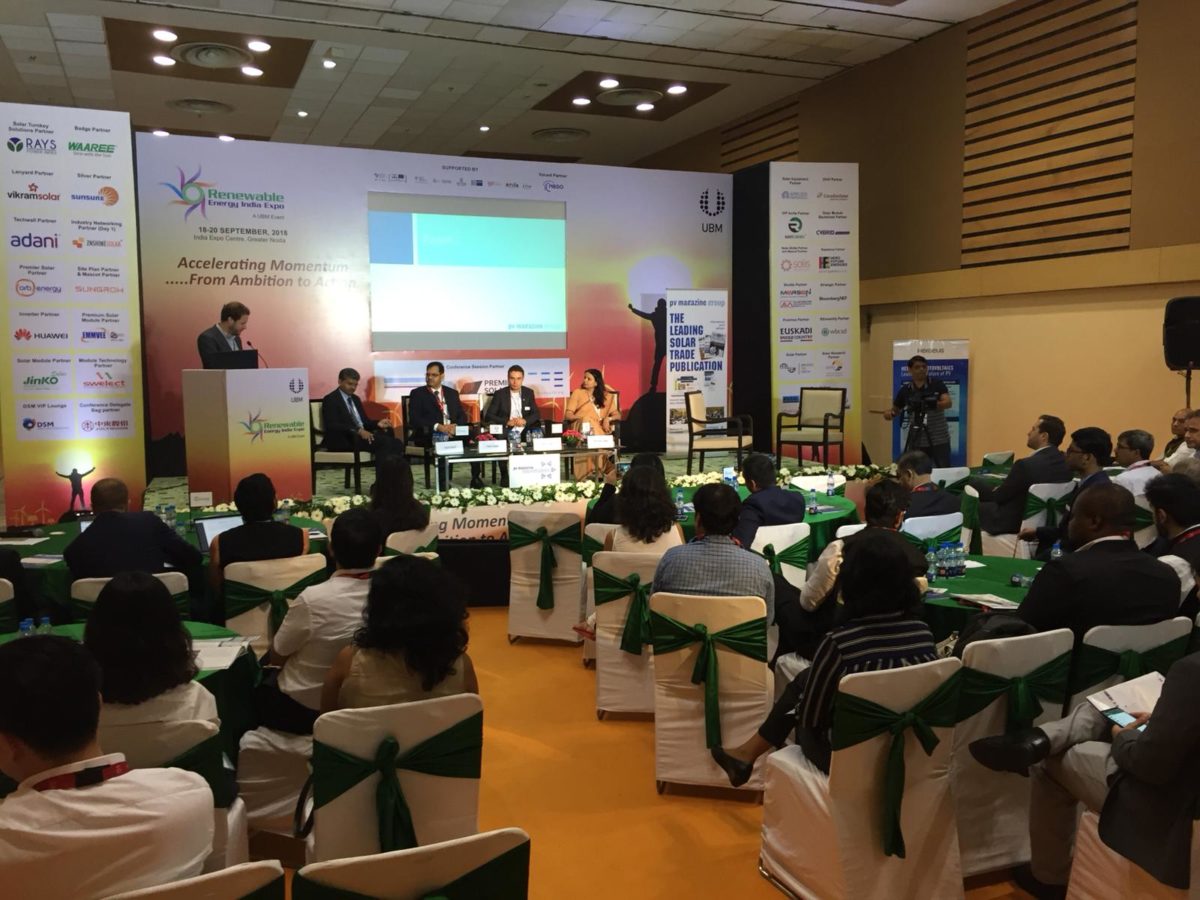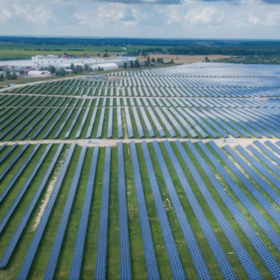Setting the stage for the first panel discussion, on bifacial technology, Fezan Sayed, head of strategy and sales, Americas, Heraeus, provided an overview of the bifacial module market, including its constraints and the supply-demand outlook.
Sayed stressed that a lack of unified standards for rear-side power generation is a major factor constraining markets outside of China, where the Top Runner Program is pushing bifacial technology.
A presentation on innovations for risk-averse environments, meanwhile, kick started the second panel discussion, on the role of standards in innovation. Panel members, including Vivek Chaturvedi, DSM regional director-solar for India, Middle East and Africa (IMEA); Subrahmanyam Pulipaka, founder and CEO, Soreva Energy Group; and Surbhi Singhvi, manager-consulting, Bridge to India, shared their perspectives on Bureau of Indian Standards (BIS) versus International Electrotechnical Commission (IEC) standards, in addition to India-specific challenges, and opportunities for solar PV material and component providers.
The questions of whether or not cost optimization and standards implementation can go hand in hand, and if the bifacial market will see standardization of power output measurement and more economical transparent backsheets, was raised by Heraeus’ Sunit Arya, head of sales, SEA, and Christoph Hartnig, head of renewables marketing. In actual conditions, bifacial modules may produce more current or voltage than under standard test conditions. So the connector ratings, and size of the controls at the PV output, etc. need to be considered accordingly.
Bifacial uptake: Cost is not the only challenge
Discussing the adoption of bifacial solar modules in India, the first panel touched upon the challenges specific to the country and how the industry is addressing them.
Distinguished panel members included Harsh Govil, vice president-production, Adani; Rahul Kapil, vice president-operations and director, Longi Solar; Daniel Greger, product manager-BU utility, SMA AG; and Karishma Dagar, managing director-India, Soltec.
Fighting costs is the biggest deterrent for bifacial manufacturers, said Harsh Govil, who put forth the manufacturers’ point of view of bifacial cells and modules. Acknowledging that bifacial is the future of power generation, not only in India, but also across the world, he said, “Though the cost of mono n- and p-type is falling, we haven’t been able to put bifacial upfront to the customers.”
He continued, “There are technologies coming out, which will bring down the pricing subsequently. And 10 years down the line, we will see 30-40% as the market for bifacial. It is evident that we have to migrate to this product, due to its inherent advantages in terms of power generation, but the real challenge comes in reducing the cost. Currently, pricing is 30-40% higher than standard monocrystalline. So there is a very hesitant atmosphere in the Indian market with respect to this product. Also, there are concerns about the lifecycle of the product.
“We at Adani are the only ones who are manufacturing bifacial cells in the country and hope that Indian customers will rise up to the situation and very soon understand that we have to fight the cost,” he concluded.
Reiterating that going forward bifacial production will be more stable, Daniel Greger from SMA, presented the challenges from an EPC perspective.
Longi’s Rahul Kapil went on to elaborate on the technology roadmap. “PERC has become a general product in the market. The next level that we are promoting is bifacial,” he said. “We believe that by 2019, PERC bifacial will become a general product. In India, Longi Solar is already supplying bifacial PERC. The next level of bifacial will be half cut bifacial, which will further increase the gain of modules.”
He continued, “From gain perspective, we have seen that multi and mono PERC give 4-5% gain. With bifacials, gain increases further (10-15%), giving more value to the customers. The only challenge is that bifacials cannot be used everywhere. To get more gain from bifacials, module height should be more than one meter. It is also important for better irradiance uniformity on the back side of the module.”
Speaking about tracking solutions for bifacial solar modules, Karishma Dagar from Soltec said that bifacial trackers are being designed to be taller and to ensure sufficient gaps between modules, so that backside shading losses are reduced.
Innovations from backsheets to solar glass coating
Vivek Chaturvedi, regional business director-solar, IMEA, DSM, stated that the solar industry must learn from other industries. According to him, manufacturers need to strike a balance of power between technologists/quality leaders and sourcing teams.
The profiles of suppliers have become vital in this tough industry, he said, which has seen existing players vanish over the years. Manufacturers need to focus on the cost of kWh more than Wp, because that is what customers are interested in.
Furthermore, products for India and similar markets must incorporate the right kinds of components, with a sourcing strategy that takes a long-term view in line with the 25-year warranties extended on them, said Chaturvedi. For example, over the last 30 years, backsheets have been the biggest reason for module underperformance and failure. Delamination, in turn, is the biggest cause for backsheet failure, he explained, adding that the best way to tackle these problems, is to eliminate lamination completely. Today, backsheets are coextruded with complete control of quality and supply chain of material.
DSM is leading this transition through Endurance backsheets, said Chaturvedi, which provide reliable performance in extreme environments, like dry deserts and hot-humid, tropical climates. The innovative material compounds DSM developed under a new co-extrusion process applied results in a backsheet that has strong water barrier properties, as well as abrasion and chemical resistance, he said. At the same time, it is cost-effective and 100% recyclable.
DSM is confident that coextrusion will represent a step change for backsheet manufacturers, with the potential for further innovation and lower cost production than is possible using lamination. The company’s Anti-Soiling coating for PV solar glass is another example of a smart development that will improve returns for solar park owners in desert-like environments, because less (scarce) resources, such as water and labor are needed to clean the panels.
Module-level power electronics
Direct current (DC) power optimizers and microinverters are, together, categorized as module-level power electronics (MLPE). Stressing their importance, Subrahmanyam Pulipaka, CEO, Soreva Energy Group, and working chairman, Africa India Youth Energy Forum, said that the use of power optimizers could increase average performance by 12.9% and cumulative peak performance by 6%. While additional costs are variable, at 15-20%, the ROI (increase in efficiency versus price per kWh) is within 28 months, he said.
MLPE shipments will grow at 18% annually through 2023, continued Pulipaka, on the back of a growing distributed generation market and a heightened focus on safety. For the Indian market, opportunities lie in designing innovative/indigenous products to serve the domestic market and new paradigms for module manufacturing. However, achieving economics of scale and lack of skilled labor do pose challenges, he said.
Quality can be ensured by streamlining operation and maintenance, and with better solar asset management. This can be achieved with digitization of solar power administration, using technologies like the Internet of Things, concluded Pulipaka.
Going eco-friendly
Raising concerns over the threat of solar PV e-waste, DSM’s Vivek Chaturvedi said that by 2050, annual PV waste will reach 10-15% of global e-waste volumes today. Material choices made today, as such, will have consequences for the end-of-life treatment in 30 years’ time, he said. This means the solar industry should avoid the use of hazardous materials and aim for maximum re-use of materials.
DSM’s Endurance backsheets have a 30% lower carbon footprint than conventional fluoro-based backsheets, continued Chaturvedi, and are 100% recyclable with no production waste. These backsheets are co-extruded, meaning a solvent-free production process. Trim-edge (production waste) can be re-melted into new plastic products. On the other hand, laminated backsheets cannot be re-melted and recycled, due to the use of crosslinking adhesives to increase interlayer strength.
Furthermore, backsheet production waste of traditional laminated backsheets is currently collected and landfilled or incinerated in waste-to-energy plants. Meanwhile, the fluoropolymer component in backsheets is non-melting and can only be processed in solution and, thus, is intrinsically non-recyclable.
DSM’s conductive backsheet (CBS) for high-power back-contact modules is an example of a circular solution by design. Instead of busbars connecting front and back sides of neighboring cells, the conductive backsheet connects cells via a metal film positioned at the backside of the cells only, which makes it much easier to recover the metal cell interconnect.
The environmental footprint of the back-contact module using CBS has been evaluated by a number of institutes and shows a positive impact, due to the higher power output (lossless cell interconnection), lead/solder-free cell interconnection and the possibility to separate the conductive metal layer from the cell and glass fraction for re-use. Finally, CBS provides a lower ecological footprint as it is fluorine-free.
Read about the discussions at the Quality Roundtable held last week in India at REI 2018, and at the Quality Roundtable in Taiwan at Energy Taiwan 2018. And watch out for coverage from the next pv magazine Roundtables at SPI in the United States this week, and All Energy Australia, next week. The video from our first Latin American Quality Roundtable is also available to view now.
This content is protected by copyright and may not be reused. If you want to cooperate with us and would like to reuse some of our content, please contact: editors@pv-magazine.com.









1 comment
By submitting this form you agree to pv magazine using your data for the purposes of publishing your comment.
Your personal data will only be disclosed or otherwise transmitted to third parties for the purposes of spam filtering or if this is necessary for technical maintenance of the website. Any other transfer to third parties will not take place unless this is justified on the basis of applicable data protection regulations or if pv magazine is legally obliged to do so.
You may revoke this consent at any time with effect for the future, in which case your personal data will be deleted immediately. Otherwise, your data will be deleted if pv magazine has processed your request or the purpose of data storage is fulfilled.
Further information on data privacy can be found in our Data Protection Policy.